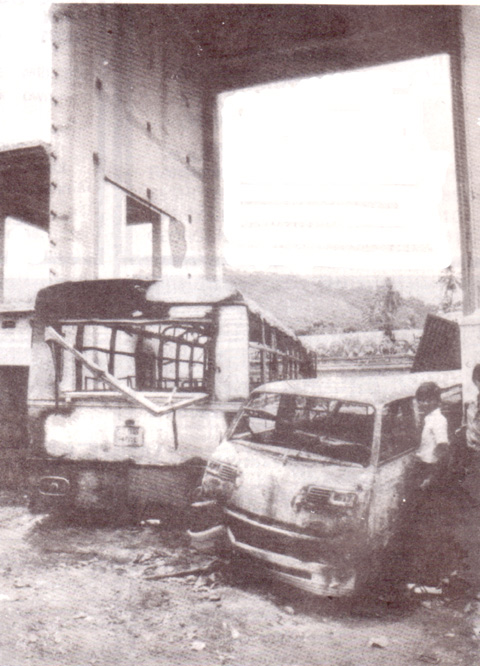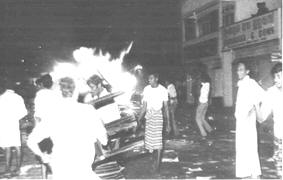|

 Black
July 1983: the Charge is Genocide Black
July 1983: the Charge is Genocide
The attacks were not confined to Colombo alone
- they spread to Kandy, Matale, Nuwara Eliya, Badulla, Bandarawela,
Negombo, and many other areas where Tamils lived amongst a
predominant Sinhala population...
The attacks were not confined to Colombo alone. They spread to
Kandy, Matale, Nuwara Eliya, Badulla, Bandarawela, Negombo, and many
other areas where Tamils lived amongst a predominant Sinhala
population.
"Violence also erupted in places such as Kandy, Matale,
Nuwara Eliya, Badulla and Bandarawela. On each of these
occasions it followed a similar pattern. The incidents were
started off by people coming in from outside the districts,
lists were used to identify Tamil property and systematic
attacks were made on it: the local people were then
encouraged to follow with further depredations..." (Patricia
Hyndman, Senior Lecturer in Law, University of New South Wales
and Secretary, Lawasia Human Rights Standing Committee - Report
on the Communal Violence in Sri Lanka, July 1983)

Two state owned buses filled with petrol were used to
burn down
the Muthu Mariamman Temple at Matale on 28 July 1983
''(A British tourist) said: 'Last Wednesday a taxi driver took us
into Negombo... and the whole town was smouldering. All the Tamil
property in the centre of the town had been burnt down. The
cigarette factory had gone up together with a cinema and a garage.
There was smoke everywhere and the whole area was a burnt out mess.
..there was no sign of any Tamil anywhere. We were told that Tamils
were being grabbed off buses by groups of people wielding iron bars.
We also saw young Sinhalese stopping cars to siphon out the petrol
so they could use it to start fires.'.. '' (London Times, 2
August 1983)
''...the looting burning and killing that began last week end in
Colombo spread to the cities of Kandy and Gampola in the central
hills...
 In
Kandy, 62 miles northeast of Colombo, mobs burned and sacked at
least 55 stores owned by members of the Tamil minority in attacks
that began Tuesday night and continued Wednesday...''
(The Guardian, 28 July 1983) In
Kandy, 62 miles northeast of Colombo, mobs burned and sacked at
least 55 stores owned by members of the Tamil minority in attacks
that began Tuesday night and continued Wednesday...''
(The Guardian, 28 July 1983)
"The town (Kandy), which lies at the centre of the tea and rubber
plantations of the central highland area of Sri Lanka has witnessed
rioting and fire bombing against Tamil owned homes and businesses
for the past four nights. And the presence of the rows of burnt out
shops and of the 6000 Tamils in five temporary camps shows that the
communal terror which has been unleashed in Sri Lanka is much more
widespread than at first reported. The testimony of similar outrages
in the villages in the steep sided hills and dense green country
around Kandy reinforces that impression...The Sinhala District
Inspector General of Police for the central range said: 'We usually
expect what we call the soda bottle effect in these things. A sudden
foaming up and then going flat but that hasn't happened yet.'... Two
unidentified bodies were fished from the artificial lake in the
centre of Kandy and a third body was found on a railway line close
to the town. The body, which had been cut and chopped, was evidently
thrown from a train..."
(The London Times, 30 July 1983)
"...News of the extent of the violence directed at the centre
of Nuwara Eliya by Sinhala mobs was somehow contained by the town's
remoteness... But no point in Colombo or the surrounding suburbs
matches the mess... Whole blocks have been reduced to charred
rubble. Only a handful of provision shops belonging to Sinhala
traders remained... Remarkably, only sixteen people died in the
inferno..." (London Daily Telegraph, 6 August 1983)
''Two weeks ago (Nuwara Eliya).. became the focal point for
much of the communal violence that has engulfed the island... We
had already been in Sri Lanka for 10 days... before the events
of 29 July. We had started in Colombo; we then fled to Kandy to
escape the violence; when it followed us there we moved to
Nuwara Eliya. Yet subsequent reports confirmed that the damage
done to Nuwara Eliya was at least the equal of anything
experienced elsewhere.. By dusk on Friday 29 July, not one
building in the central street was left standing; fire had
spread to the hills too, engulfing shops, homes and buses...''(Peter
Hartnell, New Statesman, 12 August 1983)
''In the relatively small town of Lunugala in the Badulla
District, 67 houses, 35 business establishments and two vehicles
belonging to Tamils were burnt. A leading businessman and a nun were
murdered.. In Badulla itself, according to a report in Virakesari
of 1 October 1983, quoting the government agent, 127 houses, 252
shops, four Hindu temples, four printing presses, two cinemas, one
tavern, three Tamil schools, 79 vehicles and a rural bank were
destroyed. There were 20 murders. In the nearby small town of
Passara, in the sam district, 63 houses, 21 shops, 16 vehicles and
printing press were burnt and destroyed. There were two murders...''
(N.Shanmugathasan,Sri Lanka: Racism and the Authoritarian State -
Race and Class, Volume XXVI, A.Sivanandan and Hazel Waters,
Institute of Race Relations, London)

''Holiday makers who returned to Dusseldorf said hundreds of Tamils had
been murdered and even their hotel waiter told them proudly, 'we have killed
several of them." A business consultant said a dozen houses had been burned
down near the popular seaside resort of Bentota, among them the local chemist
shop...''(Oslo Report dateline 29 July 1983 in Madras Hindu)
''Fearing adverse international reaction to photographs and TV
footage depicting the aftermath of the violence, the authorities
yesterday imposed strict censorship on all still and moving
pictures.'' (London Daily Telegraph, 2 August 1983)
...continued....
|